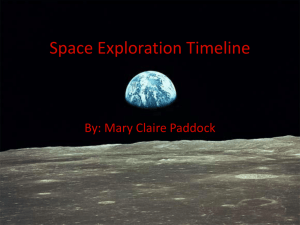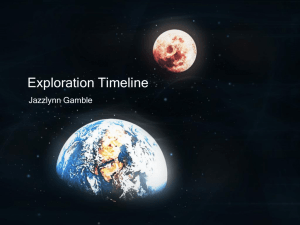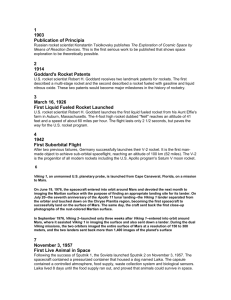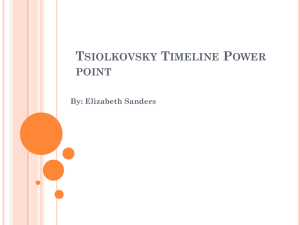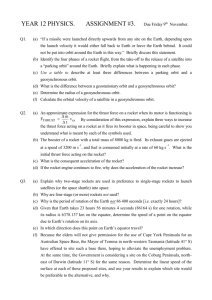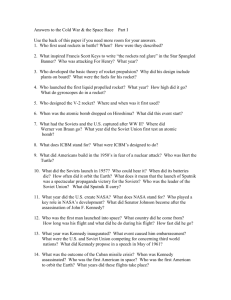space exploration timeline
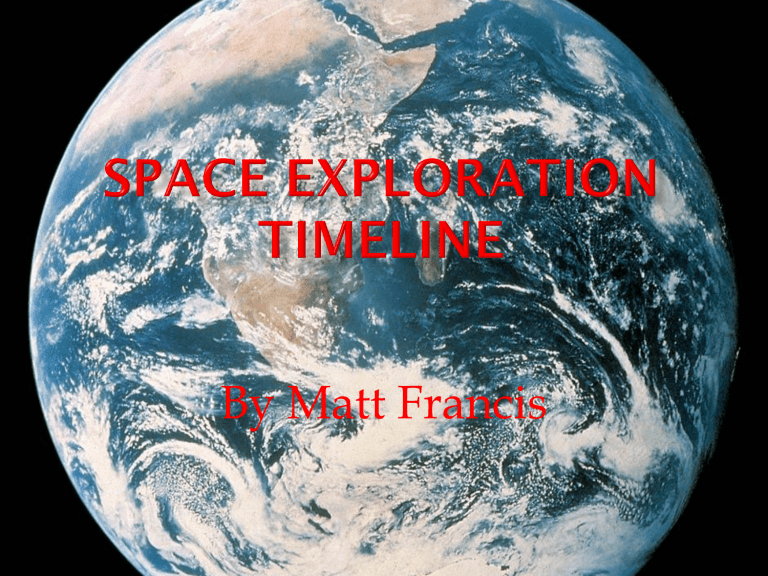
By Matt Francis
A Scientist named Tsiolkovsky started testing rockets
Russia
Published The Exploration of Cosmic Space by Means of
Reaction Devices. Konstantin Tsiolkovsky calculated that the horizontal speed required for a minimal orbit around the Earth is 8,000 m/s (5 miles per second) and that this could be achieved by means of a multistage rocket fueled by liquid oxygen and liquid.
A Scientist named Goddard patented the first rocket.
United States of America
Robert Goddard is credited with creating and building the world’s first liquid-fueled rocket. He patented a multistage rocket design and a liquid-fuel rocket design are regarded as important milestones toward spaceflight.
Goddard launches the first successful rocket.
United States of America
March 16, 1926 Robert Goddard successfully launched the world’s first liquid-fueled rocket. The beginning of space flight.
V-2 spacecraft was made.
Germany
Working for the German army, Wernher von Braun developed what eventually became known as the V-2 rocket. It was built as a weapon but eventually served as the predecessor of some of the launch vehicles used in the early space programs of the U.S. and
Soviet Union.
V-2 spacecraft left earths atmosphere
Germany
On April 22, 1943
(Contradicting Dates)
This was the first rocket to reach space, reaching an altitude of 60 miles.
Viking spacecraft reached 159 miles above the Earth.
United States of
America
On May 24, 1954 Viking
11 rose to 158 miles. It took impressive high altitude photographs of the Earth.
Soviet satellite, Sputnik, became the first manmade object to orbit Earth.
Soviet Union
October 4, 1957, Sputnik 1 was launched and demonstrated the viability of using artificial satellites to explore the upper atmosphere. It orbited Earth 1,440 times and each orbit took about 96 minutes. It was the first artificial satellite in history.
The Redstone rocket lifted
United States of America
January 31, 1961 the Mercury-Redstone 2 carried a chimpanzee named Ham 157 miles into space. It helped confirm that humans could safely make the trip.
May 5, 1961, the Mercury-Redstone 3 spacecraft was named Freedom 7 which performed a suborbital flight piloted by astronaut Alan Shepard, who became the first American in space. The flight lasted less than 16 minutes and attained an altitude of just over 116 miles.
Soviet Yuri Gagarin becomes the first space traveler.
Soviet Union
April 12, 1961 Yuri Gagarin became the first space traveler. He made a single orbit of the Earth. His flight lasted one hour and 48 minutes. His spacecraft was called the Vostok 1.
Photograph of the moon taken by Lunar Orbiter
United States of
America
1966 to 1967 the Lunar
Orbiter program was a series of five unmanned orbiter missions .It was intended to help select
Apollo landing sites by mapping the Moon's surface, they provided the first photographs from lunar orbit.
Neil Armstrong was the first man to walk on the moon.
United States
July 20, 1969, Neil
Armstrong became the first man to walk on the moon.
“That’s one small step for (a)man, one giant leap for mankind.”
First space station, Salyut 1
(ends orbit 1973)
Russia
April 19, 1971, the first space station called Salyut
1 is launched from
Baikonur Cosmodrome using a 3 stage proton launch vehicle. It completed 362 orbits before being destroyed in reentry in October 1973. Its main purpose was to study long-term spaceflight.
America launches the
Space Station.
United States of America
May 14, 1973, Skylab was the first U.S. space station and the world’s first big space station. It was launched by a Saturn V
Rocket. Its purpose was to serve as a laboratory for scientific experiments in space until 1974.
Images from satellite show Martian soin – from first space probe to land on another planet, Viking 1.
United States of America
September 3, 1976, the first U.S. space probe, Viking 1, to land on another planet. Pictures show Martian soil.
Viking experiments give the most complete look at
Mars to date.
Skylab shows the image of the sun’s carona.
United States of America
The empty Skylab spacecraft returned to
Earth on July 11, 1979, burning up in the Earth’s atmosphere, scattering debris over the Indian
Ocean and the sparsely settled region of Western
Australia.
Skylab logged about 2,000 hours of scientific and medical experiments and
127,000 frames of film of the sun. It includes 8 solar flares and produced valuable results. Existence of the Sun’s coronal holes were confirmed because of these efforts
The first re-usable shuttle,
Columbia, was launched.
United States of America
April 12, 1981, the first reuseable shuttle, Columbia, was launched. The spaceship, Columbia, continued the pioneering legacy of its forbearers, becoming the first shuttle to fly into orbit.
Challenger takes a photo of Earth that shows Australia
First Spacewalk
United States of
America
STS-6 astronauts Story
Musgrave and Don
Peterson perform the first space shuttle spacewalk (duration: 4 hours, 10 minutes).
First American Women in space.
United States of
America
STS-7 Sally Ride becomes the first
American woman to travel into space
Mir Space Station launched.
Russia
On February 20, 1986, Mir
Space Station launched. It endured 15 years in space.
It hosted scores of crew members and international visitors. Mir set every record in longduration space flight.
Valeri Palyakov lived abord the space station for
437 days, 17 hours and 38 minutes. Mir’s purpose was to maintain a longterm research outpost in space.
Hubble Telescope launched
United States of
America
Hubble Telescope was carried into orbit by the space shuttle Discovery.
The telescope can take extremely sharp images with almost no background light. The purpose of Hubble is so astronomers and even the public can better explore our galaxy and the universe.
Galileo sends back photos and data about Jupiter’s composition
United States of America
Galileo was an unmanned spacecraft sent by NASA to study the planet Jupiter and its moons. Named after the astronomer and Renaissance pioneer Galileo Galilei, it was launched on October 18, 1989 by the Space Shuttle Atlantis on the STS-34 mission. It arrived at
Jupiter on December 7, 1995, a little more than six years later, via gravitational assist flybys of
Venus and Earth. Galileo's prime mission was a two-year study of the Jovian system
Mars Pathfinder landed on Mars and released the “Rover”.
United States of America
December 4, 1996, Mars
Pathfinder, later renamed the
Carl Sagan Memorial Station, landed the first roving probe deployed on another planet. It consisted of a lander and a lightweight (10.6 kilograms/23 pounds) wheeled robotic rover named Sojourner.The Sojourner carried out a series of scientific instruments to analyze the
Martian atmosphere, climate, and geology.
First modules of the
International Space Station launched.
Unites States of America,
Russia
The International Space
Station (ISS) is an internationally developed research facility that is being assembled in low Earth orbit.
The ISS has been the most politically complex space exploration program ever undertaken. It includes the countries of the United
States, Russia, Europe, Japan, and Canada.
The ISS serves as a research laboratory that has a environment in which crews conduct experiments in biology, chemistry, medicine, physiology and physics, as well as astronomy and meteorological observations.
The station provides a unique environment for the testing of the spacecraft systems that will be required for missions to the Moon and
Mars.
